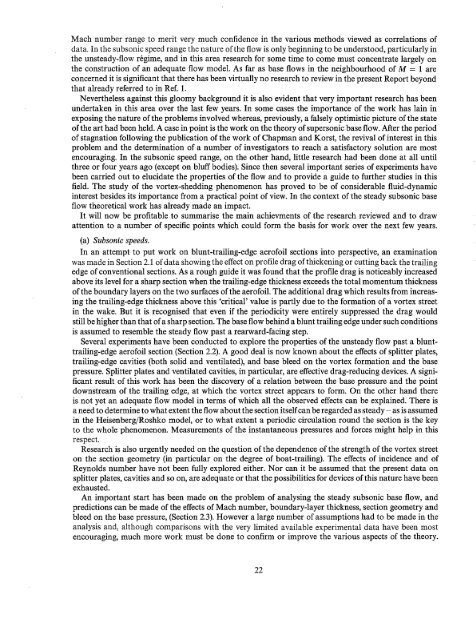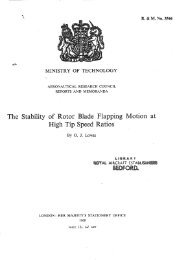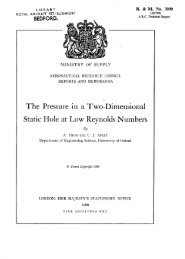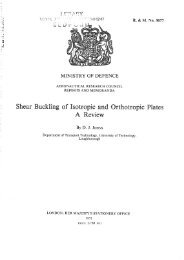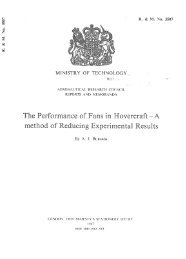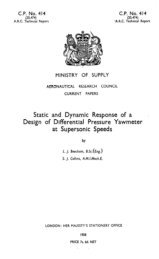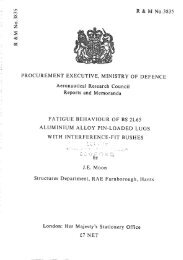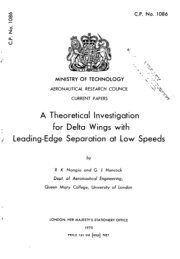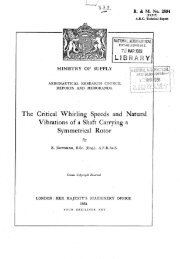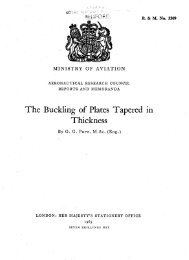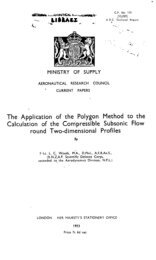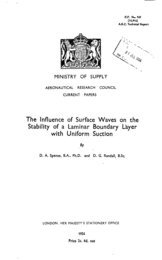A Discussion of Two-Dimensional Turbulent Base Flows - aerade
A Discussion of Two-Dimensional Turbulent Base Flows - aerade
A Discussion of Two-Dimensional Turbulent Base Flows - aerade
Create successful ePaper yourself
Turn your PDF publications into a flip-book with our unique Google optimized e-Paper software.
Mach number range to merit very much confidence in the various methods viewed as correlations <strong>of</strong><br />
data. In the subsonic speed range the nature <strong>of</strong> the flow is only beginning to be understood, particularly in<br />
the unsteady-flow rdgime, and in this area research for some time to come must concentrate largely on<br />
the construction <strong>of</strong> an adequate flow model. As far as base flows in the neighbourhood <strong>of</strong> M = 1 are<br />
concerned it is significant that there has been virtually no research to review in the present Report beyond<br />
that already referred to in Ref. 1.<br />
Nevertheless against this gloomy background it is also evident that very important research has been<br />
undertaken in this area over the last few years. In some cases the importance <strong>of</strong> the work has lain in<br />
exposing the nature <strong>of</strong> the problems involved whereas, previously, a falsely optimistic pictur e <strong>of</strong> the state<br />
<strong>of</strong> the art had been held. A case in point is the work on the theory <strong>of</strong> supersonic base flow. After the period<br />
<strong>of</strong> stagnation following the publication <strong>of</strong> the work <strong>of</strong> Chapman and Korst, the revival <strong>of</strong> interest in this<br />
problem and the determination <strong>of</strong> a number <strong>of</strong> investigators to reach a satisfactory solution are most<br />
encouraging. In the subsonic speed range, on the other hand, little research had been done at all until<br />
three or four years ago (except on bluff bodies). Since then several important series <strong>of</strong> experiments have<br />
been carried out to elucidate the properties <strong>of</strong> the flow and to provide a guide to further studies in this<br />
field. The study <strong>of</strong> the vortex-shedding phenomenon has proved to be <strong>of</strong> considerable fluid-dynamic<br />
interest besides its importance from a practical point <strong>of</strong> view. In the context <strong>of</strong> the steady subsonic base<br />
flow theoretical work has already made an impact.<br />
It will now be pr<strong>of</strong>itable to summarise the main achievments <strong>of</strong> the research reviewed and to draw<br />
attention to a number <strong>of</strong> specific points which could form the basis for work over the next few years.<br />
(a) Subsonic speeds.<br />
In an attempt to put work on blunt-trailing-edge aer<strong>of</strong>oil sections into perspective, an examination<br />
was made in Section 2.1 <strong>of</strong> data showing the effect on pr<strong>of</strong>ile drag <strong>of</strong> thickening or cutting back the trailing<br />
edge <strong>of</strong> conventional sections. As a rough guide it was found that the pr<strong>of</strong>ile drag is noticeably increased<br />
above its level for a sharp section when the trailing-edge thickness exceeds the total momentum thickness<br />
<strong>of</strong> the boundary layers on the two surfaces <strong>of</strong> the aer<strong>of</strong>oil. The additional drag which results from increas-<br />
ing the trailing-edge thickness above this 'critical' value is partly due to the formation <strong>of</strong> a vortex street<br />
in the wake. But it is recognised that even if the periodicity were entirely suppressed the drag would<br />
still be higher than that <strong>of</strong> a sharp section. The base flow behind a blunt trailing edge under such conditions<br />
is assumed to resemble the steady flow past a rearward-facing step.<br />
Several experiments have been conducted to explore the properties <strong>of</strong> the unsteady flow past a blunt-<br />
trailing-edge aer<strong>of</strong>oil section (Section 2.2). A good deal is now known about the effects <strong>of</strong> splitter plates,<br />
trailing-edge cavities (both solid and ventilated), and base bleed on the vortex formation and the base<br />
pressure. Splitter plates and ventilated cavities, in particular, are effective drag-reducing devices. A signi-<br />
ficant result <strong>of</strong> this work has been the discovery <strong>of</strong> a relation between the base pressure and the point<br />
downstream <strong>of</strong> the trailing edge, at which the vortex street appears to form. On the other hand there<br />
is not yet an adequate flow model in terms <strong>of</strong> which all the observed effects can be explained. There is<br />
a need to determine to what extent the flow about the section itself can be regarded as steady- as is assumed<br />
in the Heisenberg/Roshko model, or to what extent a periodic circulation round the section is the key<br />
to the whole phenomenon. Measurements <strong>of</strong> the instantaneous pressures and forces might help in this<br />
respect.<br />
Research is also urgently needed on the question <strong>of</strong> the dependence <strong>of</strong> the strength <strong>of</strong> the vortex street<br />
on the section geometry (in particular on the degree <strong>of</strong> boat-trailing). The effects <strong>of</strong> incidence and <strong>of</strong><br />
Reynolds number have not been fully explored either. Nor can it be assumed that the present data on<br />
splitter plates, cavities and so on, are adequate or that the possibilities for devices <strong>of</strong> this nature have been<br />
exhausted.<br />
An important start has been made on the problem <strong>of</strong> analysing the steady subsonic base flow, and<br />
predictions can be made <strong>of</strong> the effects <strong>of</strong> Mach number, boundary-layer thickness, section geometry and<br />
bleed on the base pressure, (Section 2.3). However a large number <strong>of</strong> assumptions had to be made in the<br />
analysis and, although comparisons with the very limited available experimental data have been most<br />
encouraging, much more work must be done to confirm or improve the various aspects <strong>of</strong> the theory.<br />
22


